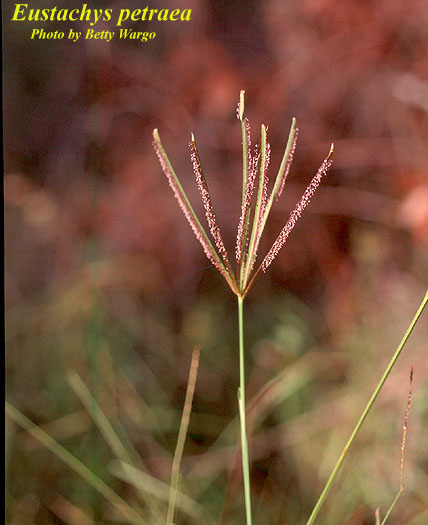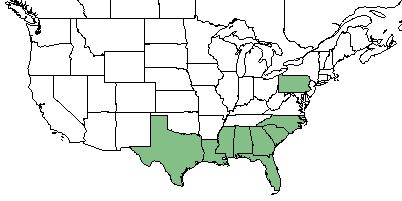Difference between revisions of "Eustachys petraea"
(→Distribution) |
HaleighJoM (talk | contribs) (→Ecology) |
||
| (6 intermediate revisions by 4 users not shown) | |||
| Line 19: | Line 19: | ||
}} | }} | ||
==Taxonomic Notes== | ==Taxonomic Notes== | ||
| − | Synonyms: ''Chloris petraea'' Swartz | + | Synonyms: ''Chloris petraea'' Swartz.<ref name="weakley">Weakley, A.S. 2015. Flora of the southern and mid-atlantic states. Working Draft of 21 May 2015. University of North Carolina at Chapel Hill, Chapel Hill, North Carolina.</ref> |
| + | |||
| + | Varieties: none.<ref name="weakley">Weakley, A.S. 2015. Flora of the southern and mid-atlantic states. Working Draft of 21 May 2015. University of North Carolina at Chapel Hill, Chapel Hill, North Carolina.</ref> | ||
==Description== | ==Description== | ||
<!-- Basic life history facts such as annual/perrenial, monoecious/dioecious, root morphology, seed type, etc. --> | <!-- Basic life history facts such as annual/perrenial, monoecious/dioecious, root morphology, seed type, etc. --> | ||
| − | ''E. petraea'' is a perennial graminoid of the ''Poaceae'' family | + | ''E. petraea'' is a perennial graminoid of the ''Poaceae'' family.<ref name= "USDA Plant Database"> USDA Plant Database [https://plants.usda.gov/core/profile?symbol=EUPE9 https://plants.usda.gov/core/profile?symbol=EUPE9] </ref> It can reach heights of up to 30 inches tall.<ref>[[https://www.wildflower.org/plants/search.php?search_field=&newsearch=true]] Lady Bird Johnson Wildflower Center. Accessed: May 13, 2019</ref> |
==Distribution== | ==Distribution== | ||
| Line 30: | Line 32: | ||
==Ecology== | ==Ecology== | ||
===Habitat=== <!--Natural communities, human disturbed habitats, topography, hydrology, soils, light, fire regime requirements for removal of competition, etc.--> | ===Habitat=== <!--Natural communities, human disturbed habitats, topography, hydrology, soils, light, fire regime requirements for removal of competition, etc.--> | ||
| − | ''E. petraea'' is foud in dune slacks and sand flats, as well as sometimes in disturbed areas. <ref name= "Weakley 2015"> Weakley, A. S. (2015). Flora of the Southern and Mid-Atlantic States. Chapel Hill, NC, University of North Carolina Herbarium. </ref> Specimens have been collected from borders of mesic woodlands, loamy sands, coastal hammock, open pine woods, pond bottom, mangrove flats, palm flatwoods, disturbed sands, river banks, river bottoms, and wiregrass longleaf pine sands. <ref name = "FSU herbarium"> URL: http://herbarium.bio.fsu.edu. Last accessed: June 2018. Collectors: Loran C. Anderson, R.K. Godfrey, R.E. Perdue, D.B. Ward, Robert R> Haynes, Gwynn W. Ramsey, R. S. Mitchell, Tom Barnes, Richard Houk, R. Kral, J. P. Gillespie, S.W. Leonard, Robert Lemaire, D.B. Ward, D. Burch, George Cooley, Erdman West, Tom Daggy, Robert lazor, Frank Goul, Dorothy C. Saunders, Wilbur Duncan, Sidney McDaniel, Patrick Brennan, Mabel Kral, R.A. Norris, Richard R. Clinebell II, E. West, L. Arnold, J.A. Duke, Edwin Tyson, K. MacClendon, T. MacClendon, B. Boothe, J. Kartesz, V. Craig, R. Mears, G. Wilder, Wayne D. Longbottom, David Williams, M. Darst, H. Light, J. Good, L. Peed. States and counties: Florida (Dixie, Jefferson, Holmes, Seminole, Calhoun, Liberty, Leon, Citrus, Okaloosa, Monroe, Lee, Osceola, Highlands, Bay, Levy, Palm Beach, Sumter, Madison, Polk, Taylor, Collier, Manatee, Columbia, Indian River, Orange, Lake, Lake, Alachua, Okeechobee, Walton, Gadsden, Wakulla) Georgia (Thomas, Calhoun, Franklin)</ref> | + | ''E. petraea'' is foud in dune slacks and sand flats, as well as sometimes in disturbed areas. <ref name= "Weakley 2015"> Weakley, A. S. (2015). Flora of the Southern and Mid-Atlantic States. Chapel Hill, NC, University of North Carolina Herbarium. </ref> Specimens have been collected from borders of mesic woodlands, loamy sands, coastal hammock, open pine woods, pond bottom, mangrove flats, palm flatwoods, disturbed sands, river banks, river bottoms, and wiregrass longleaf pine sands. <ref name = "FSU herbarium"> URL: http://herbarium.bio.fsu.edu. Last accessed: June 2018. Collectors: Loran C. Anderson, R.K. Godfrey, R.E. Perdue, D.B. Ward, Robert R> Haynes, Gwynn W. Ramsey, R. S. Mitchell, Tom Barnes, Richard Houk, R. Kral, J. P. Gillespie, S.W. Leonard, Robert Lemaire, D.B. Ward, D. Burch, George Cooley, Erdman West, Tom Daggy, Robert lazor, Frank Goul, Dorothy C. Saunders, Wilbur Duncan, Sidney McDaniel, Patrick Brennan, Mabel Kral, R.A. Norris, Richard R. Clinebell II, E. West, L. Arnold, J.A. Duke, Edwin Tyson, K. MacClendon, T. MacClendon, B. Boothe, J. Kartesz, V. Craig, R. Mears, G. Wilder, Wayne D. Longbottom, David Williams, M. Darst, H. Light, J. Good, L. Peed. States and counties: Florida (Dixie, Jefferson, Holmes, Seminole, Calhoun, Liberty, Leon, Citrus, Okaloosa, Monroe, Lee, Osceola, Highlands, Bay, Levy, Palm Beach, Sumter, Madison, Polk, Taylor, Collier, Manatee, Columbia, Indian River, Orange, Lake, Lake, Alachua, Okeechobee, Walton, Gadsden, Wakulla) Georgia (Thomas, Calhoun, Franklin)</ref> |
| + | |||
| + | Associated species include ''Dichanthelium aciculare'', ''D. tenue'', ''Sabal palmetto'', ''Quercus laevis'', ''Quercus'' sp., ''Pinus palustris'', ''Panicum gymnocarpon'', ''Polygonum densiflorum'', ''Aristida'' sp., and other various grasses and sedges.<ref name= "FSU herbarium"/> | ||
| + | |||
===Phenology=== <!--Timing off flowering, fruiting, seed dispersal, and environmental triggers. Cite PanFlora website if appropriate: http://www.gilnelson.com/PanFlora/ --> | ===Phenology=== <!--Timing off flowering, fruiting, seed dispersal, and environmental triggers. Cite PanFlora website if appropriate: http://www.gilnelson.com/PanFlora/ --> | ||
Generally, ''E. petraea'' flowers from June until October as well as sometimes in May.<ref name= "Weakley 2015"/> It has been observed to flower in September.<ref name= "PanFlora"> Nelson, G. PanFlora: Plant data for the eastern United States with emphasis on the Southeastern Coastal Plains, Florida, and the Florida Panhandle. www.gilnelson.com/PanFlora/ Accessed: 21 MAY 2018 </ref> | Generally, ''E. petraea'' flowers from June until October as well as sometimes in May.<ref name= "Weakley 2015"/> It has been observed to flower in September.<ref name= "PanFlora"> Nelson, G. PanFlora: Plant data for the eastern United States with emphasis on the Southeastern Coastal Plains, Florida, and the Florida Panhandle. www.gilnelson.com/PanFlora/ Accessed: 21 MAY 2018 </ref> | ||
| Line 37: | Line 42: | ||
<!--===Fire ecology===--> <!--Fire tolerance, fire dependence, adaptive fire responses--> | <!--===Fire ecology===--> <!--Fire tolerance, fire dependence, adaptive fire responses--> | ||
<!--===Pollination===--> | <!--===Pollination===--> | ||
| − | <!--=== | + | <!--===Herbivory and toxicology===--> |
| − | <!--==Diseases and parasites==--> | + | <!--===Diseases and parasites===--> |
| − | ==Conservation and | + | ==Conservation, cultivation, and restoration== |
| + | This species is considered vulnerable in the state of North Carolina.<ref>[[http://explorer.natureserve.org]] NatureServe Explorer. Accessed: May 13, 2019</ref> | ||
| − | == | + | ==Cultural use== |
==Photo Gallery== | ==Photo Gallery== | ||
<gallery widths=180px> | <gallery widths=180px> | ||
</gallery> | </gallery> | ||
==References and notes== | ==References and notes== | ||
Latest revision as of 15:47, 30 June 2022
Common name: pinewoods fingergrass [1], dune fingergrass [2]
| Eustachys petraea | |
|---|---|

| |
| Photo by the Atlas of Florida Plants Database | |
| Scientific classification | |
| Kingdom: | Plantae |
| Division: | Magnoliophyta - Flowering plants |
| Class: | Liliopsida - Moncots |
| Order: | Poales |
| Family: | Poaceae |
| Genus: | Eustachys |
| Species: | E. petraea |
| Binomial name | |
| Eustachys petraea (Sw.) | |

| |
| Natural range of Eustachys petraea from USDA NRCS Plants Database. | |
Contents
Taxonomic Notes
Synonyms: Chloris petraea Swartz.[3]
Varieties: none.[3]
Description
E. petraea is a perennial graminoid of the Poaceae family.[1] It can reach heights of up to 30 inches tall.[4]
Distribution
E. petraea is native along the southeastern coast of the United States from Texas to North Carolina and Pennsylvania, Puerto Rico, and the U.S, Virgin Islands, and has been introduced to Hawaii and the Pacific Basin. [1] It is also native south of the United States from Mexico south to Panama.[2]
Ecology
Habitat
E. petraea is foud in dune slacks and sand flats, as well as sometimes in disturbed areas. [2] Specimens have been collected from borders of mesic woodlands, loamy sands, coastal hammock, open pine woods, pond bottom, mangrove flats, palm flatwoods, disturbed sands, river banks, river bottoms, and wiregrass longleaf pine sands. [5]
Associated species include Dichanthelium aciculare, D. tenue, Sabal palmetto, Quercus laevis, Quercus sp., Pinus palustris, Panicum gymnocarpon, Polygonum densiflorum, Aristida sp., and other various grasses and sedges.[5]
Phenology
Generally, E. petraea flowers from June until October as well as sometimes in May.[2] It has been observed to flower in September.[6]
Conservation, cultivation, and restoration
This species is considered vulnerable in the state of North Carolina.[7]
Cultural use
Photo Gallery
References and notes
- ↑ 1.0 1.1 1.2 USDA Plant Database https://plants.usda.gov/core/profile?symbol=EUPE9
- ↑ 2.0 2.1 2.2 2.3 Weakley, A. S. (2015). Flora of the Southern and Mid-Atlantic States. Chapel Hill, NC, University of North Carolina Herbarium.
- ↑ 3.0 3.1 Weakley, A.S. 2015. Flora of the southern and mid-atlantic states. Working Draft of 21 May 2015. University of North Carolina at Chapel Hill, Chapel Hill, North Carolina.
- ↑ [[1]] Lady Bird Johnson Wildflower Center. Accessed: May 13, 2019
- ↑ 5.0 5.1 URL: http://herbarium.bio.fsu.edu. Last accessed: June 2018. Collectors: Loran C. Anderson, R.K. Godfrey, R.E. Perdue, D.B. Ward, Robert R> Haynes, Gwynn W. Ramsey, R. S. Mitchell, Tom Barnes, Richard Houk, R. Kral, J. P. Gillespie, S.W. Leonard, Robert Lemaire, D.B. Ward, D. Burch, George Cooley, Erdman West, Tom Daggy, Robert lazor, Frank Goul, Dorothy C. Saunders, Wilbur Duncan, Sidney McDaniel, Patrick Brennan, Mabel Kral, R.A. Norris, Richard R. Clinebell II, E. West, L. Arnold, J.A. Duke, Edwin Tyson, K. MacClendon, T. MacClendon, B. Boothe, J. Kartesz, V. Craig, R. Mears, G. Wilder, Wayne D. Longbottom, David Williams, M. Darst, H. Light, J. Good, L. Peed. States and counties: Florida (Dixie, Jefferson, Holmes, Seminole, Calhoun, Liberty, Leon, Citrus, Okaloosa, Monroe, Lee, Osceola, Highlands, Bay, Levy, Palm Beach, Sumter, Madison, Polk, Taylor, Collier, Manatee, Columbia, Indian River, Orange, Lake, Lake, Alachua, Okeechobee, Walton, Gadsden, Wakulla) Georgia (Thomas, Calhoun, Franklin)
- ↑ Nelson, G. PanFlora: Plant data for the eastern United States with emphasis on the Southeastern Coastal Plains, Florida, and the Florida Panhandle. www.gilnelson.com/PanFlora/ Accessed: 21 MAY 2018
- ↑ [[2]] NatureServe Explorer. Accessed: May 13, 2019